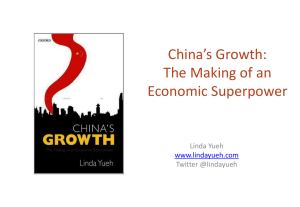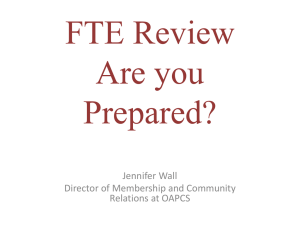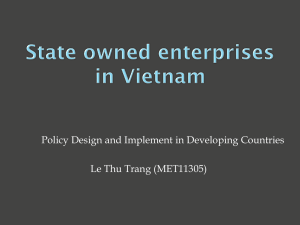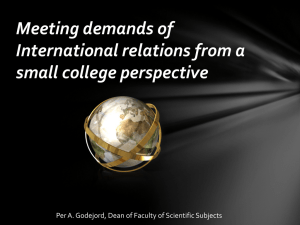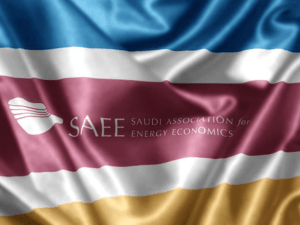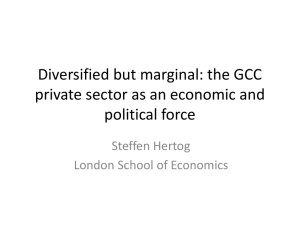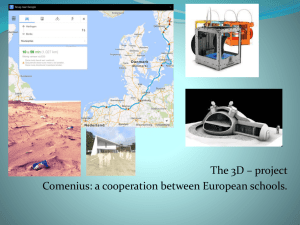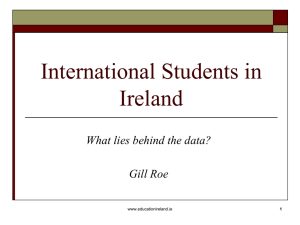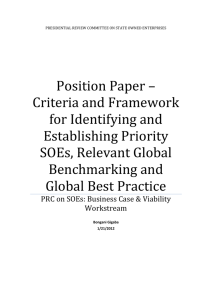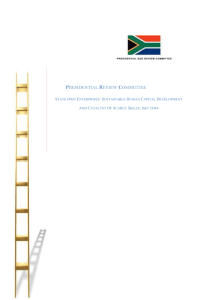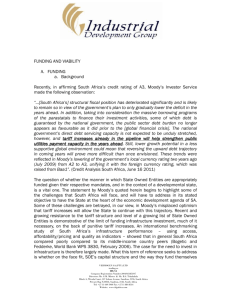PowerPoint ****
advertisement
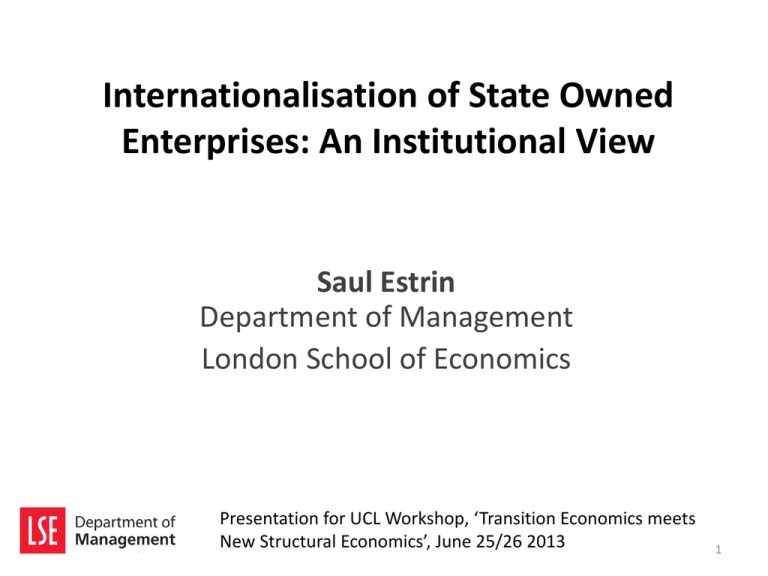
Internationalisation of State Owned Enterprises: An Institutional View Saul Estrin Department of Management London School of Economics Presentation for UCL Workshop, ‘Transition Economics meets New Structural Economics’, June 25/26 2013 1 • Paper joint with: • Klaus Meyer, CEIBS, Shanghai, China • Bo Nielsen, Copenhagen Business School • Sabina Nielsen, Copenhagen Business School 2 Outline • Theoretical framework • State ownership and internationalisation • Benevolent( “Helping hand”) and non-benevolent (“grabbing hand”) managerial motives • Institutions and State ownership • Hypotheses • Informal institutions • Formal institutions • Governance • Data • Results • Conclusions 3 Outward FDI Flows Worldwide 1970 - 2010 [Source: Created based on data obtained from UNCTAD FDI database] FDI Stock 1980 to 2010 20% Other Emerging 100% South Africa 18% Developed 90% Russia NIE 16% 14% Other Emerging BRICS India 80% China 70% Brazil Taiwan (RoC) 60% 12% Singapore 50% 10% Korea (Rep) Hong Kong 40% 8% Other developed 30% 6% Japan France 20% 4% Germany 10% UK 2% 0% 1980 0% 1980 1985 1990 1995 2000 2005 2010 1985 1990 1995 2000 2005 2010 USA State Ownership and Internationalisation • Theories of internationalisation focus on firm specific resources and capabilities • As share of FDI from developed economies declines, increasing heterogeneity of organisation forms and ownership; i.e. state ownership of enterprises (SOEs) • Research question: How does state ownership impact on firm’s internationalisation? – SOEs differ from private firms in objectives, attitudes to risk and access to resources – Impact of these differences influenced by specifics of local institutional environment. – Build on Williamson, 2000 hierarchy of institutions – informal, formal, corporate governance. 6 Institutions, State Ownership and Internationalisation • Institutions affect firm’s allocation of resources to international operations in both markets and hierarchies (SOEs). Institutions constrain decision makers in SOEs by limiting ability of insiders to exploit SOE for own objectives The more that institutions constrain leaders in SOEs, the more likely that SOEs pursue ‘benevolent’ objectives and their internationalisation strategies resemble those of private firms. • Very little literature on SOEs and internationalisation; Mazzolini 1979, Vernon 1979 and recent work on China (Ramasamy et al 2012, Wang 2012) • Two recent papers on other countries: – Spain (Garcia-Canul and Gwellen, 2008) – Norway (Knutsen et al 2011) • No work on how institutions moderate internationalisation of SOEs 7 SOEs, Institutions and Internationalisation • Distinguish ‘benevolent’ (Helping hand) contribution of SOEs to society and non –benevolent “grabbing hand” (Shleifer and Vishny, 1998) • Benevolent impact depends on political economy and institutions e.g. – in liberal economies, SOEs address market failures – in social democracies, SOEs redistribute income – in state capitalist and transition economies, SOEs guide economic development • Grabbing hand – SOEs used by politicians to exploit state apparatus in pursuit of personal and political gain. – Used by managers to extract rents • If benevolent motives dominate, SOE acts like private firms, perhaps with certain objectives added • If non-benevolent motives dominate, SOEs used to extract rents, which are usually found domestically 8 Institutions and SOEs • The extent SOEs follow benevolent or nonbenevolent motives depends on local institutional context – Private firms benefit from good institutions at all levels – increase resources available and enhance internationalisation strategies – Same applies to SOEs – inspire monitoring and shift balance in favour of benevolent managerial strategies – Hence interactions with institutions moderate SOE strategies to internationalise 9 Figure 1: Theoretical Framework derived from Williamson (2000) Informal institutions State Ownership Formal institutions Governance institutions Allocation of resources to international operations 10 Hypothesis 1: Informal Institutions • Informal institutions represent a cultural filter that provides continuity (North, 1990). Not prone to deliberate change (Hofstede, 1991). • Most relevant concept is Hofstede’s 1980 “power distance” – “extent to which less powerful members of organisations … accept and expect power is distributed unequally”. • High power distance makes organisations less entrepreneurial and competitive in global markets. Decision makers less likely to be challenged. Also discourages risk taking e.g. internationalisation. • High power distance places the leader in greater authority – in SOEs, more likely to use power to pursue political interest and rent extraction. H1: Informal institution of power distance will have a negative effect on the relationship between state ownership and internationalisation. 11 Hypothesis 2: Formal institutions • Operating in vaguely defined or weakly enforced legal framework reduces constraints on self serving objectives, especially in SOEs. • Weak formal institutions raise importance of non-market capabilities, i.e. lobbying, government relationship etc. These cannot be easily leveraged into foreign markets. • Hence, strong institutions more likely to ensure SOEs have benevolent rather than non-benevolent motives. H2: Better formulated and enforced institutions of the rule of law will have a positive effect on the relationship between state ownership and internationalisation 12 Hypothesis 3: Governance • Effectiveness of domestic capital markets has greatest effect on behaviour of firms. Acts as benchmarks to assess performance and in aligning managerial and investor objectives. • Listed SOEs subject to state and (minority) private owners. • Deviations towards non-benevolent objectives, which militate against internationalisation, are harder to conceal and to implement as capital market institutions improve. H3: Higher levels of development of the governance institution of capital markets will have a positive effect on the relationship between state ownership and internationalisation. 13 Figure 2: Framework for Empirical Testing Informal institutions State Ownership H1 Formal institutions H2 Governance institutions H3 Internationalization 14 Data • Sample from Worldscope, for world’s largest 5000 firms based on sales in 2010. • Thomson One Banker used for firm level data, except ownership data from Orbis. • Country level data from World Bank and Hofstede, 2001. • Sample contains 153 SOEs (firm with >50% equity held by state). For example from the Top 100 in 2010: – There were ten Chinese firms, 9 were SOEs – There were two Brazilian firms, both were SOEs • Matched sample created from the remaining 4847 firms by size (sales) and industry (SIC) 15 Table 1: Sample Matched by Industry and Size Country Argentina Australia Austria Belgium Bahrain Brazil Canada Switzerland China Germany Finland France United Kingdom Greece Hong Kong Indonesia India Ireland Israel Italy POE 0 2 0 1 1 1 3 3 3 10 2 4 SOE 1 1 1 2 0 8 0 2 36 2 1 4 Total 1 3 1 3 1 9 3 5 39 12 3 8 7 0 2 2 4 0 2 7 0 2 8 5 36 1 0 2 7 2 10 7 40 1 2 9 Country Japan Kuwait Malaysia Holland Norway Pakistan Philippines Poland Portugal Qatar Russia Saudi Arabia POE 25 0 0 1 0 0 3 0 1 0 5 1 SOE 1 1 3 0 3 2 0 3 0 2 15 3 Tota l 26 1 3 1 3 2 3 3 1 2 20 4 Singapore Sweden Thailand Turkey Taiwan USA South Africa United Arab Emirates Total 1 4 1 1 3 51 2 0 153 3 1 2 0 0 0 0 2 153 4 5 3 1 3 51 2 2 306 16 Measures • Dependent variable: foreign assets/total sales • Focal variable: State ownership: defined as whether a state entity controls more than 50% of the firms’s equity • Moderating variables: – Informal institutions (power distance) measure by Hofstede’s cultural dimension score – Formal institutions measure by “rule of law” from Worldwide Governance Indicators (Kaufman et al 2010) – Governance institutions by capital market development, i.e. share price x number of shares outstanding as percentage of GDP (World Bank 2010). • Estimated using Tobit because left-centred. 17 Control Variables • Country level – GDP per capita ($) • Industry level (3-digit SIC) – Industry concentration (“C4”) – Industry growth (%) – Resource based industries (SIC < 1500). • Firm level – Product diversification (entropy measure) – size (log employees) – R&D expenditures (% of sales) VIF and correlation tables shows high interdependency between institutional variables so included separately and with interaction. Descriptive statistics and correlations Variable Internationalization State ownership Mean 0.13 0.5 St.d. 0.21 0.5 1 1 -.18 R&D intensity 0.59 1.72 .21 R&D presence 0.44 0.5 .15 Firm size Product diversification 9.13 0.73 1.51 0.52 .10 .11 45.38 40.91 .11 Industry growth 0.03 0.06 -.09 Industry concentration 0.63 0.22 .09 .05 .12 0.1 685.9 7 0.3 .05 .13 898.06 -.20 .23 Power distance 62.2 20.03 -.21 Rule of law Capital market development 0.69 103.8 4 0.93 .33 80.4 .19 9.58 1.33 .33 .59 .55 .01 .56 Firm age Resource-based industry Currency reserves GDP per capita a Currency reserves is in $ billions. All correlations = .11 or above are significant at p<.05 2 3 1 .22 .14 1 .19 .10 .12 .39 .01 .05 .13 .04 4 1 .11 .04 .05 .08 5 6 1 .17 1 .14 .06 .05 .08 .20 .04 .09 .09 .03 .09 .04 .03 .06 .17 .18 .14 .03 .10 .22 .06 .15 .10 .21 .12 .09 .05 .11 .09 .03 .04 .07 .02 7 1 .06 .09 .12 .26 .25 8 9 1 .14 .27 1 .01 .23 .03 .20 .27 .01 .00 .20 .01 .03 .13 .00 .22 .11 10 11 12 13 14 15 1 .08 1 .12 .19 .32 .38 .12 .27 .02 .13 1 .83 .09 .72 1 .31 1 .83 .17 1 19 Results • H1 supported - Positive significant moderating influence of power distance on internationalisation of SOEs • H2 supported – positive significant moderating influence of rule of law on internationalisation of SOEs • H3 supported – positive significant moderates impact of market capitalisationon internationalisation of SOEs 20 Estimation of Tobit regressions for internationalization Variable Model 1 Intercept R&D intensity R&D presence Model 2 Product diversification Firm age Industry growth Industry concentration Currency reserves GDP per capita State ownership Model 5 Model 6 Model 7 *** -1.19 (0.28) *** -1.15 (0.27) *** -0.66 (0.32) * -0.56 (0.32) + -1.06 (0.23) *** -1.04 (0.23) *** 0.03 (0.01) ** 0.03 (0.01) ** 0.03 (0.01) ** 0.03 (0.01) ** 0.03 (0.01) ** 0.03 (0.01) ** 0.03 (0.01) ** 0.02 (0.05) 0.03 (0.05) 0.01 (0.05) 0.02 (0.05) 0.04 (0.05) 0.05 (0.04) 0.03 (0.01) * 0.04 (0.01) * 0.04 (0.01) ** 0.03 (0.01) * 0.04 (0.01) ** 0.04 (0.01) ** 0.04 (0.01) ** 0.11 (0.04) ** 0.12 (0.04) ** 0.11 (0.04) ** 0.11 (0.04) ** 0.10 (0.04) ** 0.12 (0.04) ** 0.11 (0.04) ** 0.00 (0.00) 0.00 (0.00) 0.00 (0.00) 0.00 (0.00) 0.00 (0.00) 0.00 (0.00) 0.00 (0.00) 0.06 (0.37) 0.06 (0.38) 0.09 (0.37) 0.01 (0.36) 0.04 (0.36) 0.02 (0.36) 0.05 (0.35) -0.13 (0.10) Resource-based industry Model 4 -1.14 (0.24) 0.03 (0.05) Firm size Model 3 -0.13 (0.10) -0.10 (0.10) -0.14 (0.10) -0.14 (0.10) -0.12 (0.10) -0.11 (0.09) 0.19 (0.07) ** 0.20 (0.07) ** 0.19 (0.07) ** 0.21 (0.07) ** 0.20 (0.07) ** 0.17 (0.07) * 0.18 (0.07) * -0.00 (0.00) *** -0.00 (0.00) ** -0.00 (0.00) * -0.00 (0.00) * -0.00 (0.00) + -0.00 (0.00) ** -0.00 (0.00) ** 0.09 (0.02) *** 0.09 (0.02) *** 0.08 (0.02) *** *** 0.07 (0.02) ** -0.05 (0.05) Informal (Power distance) -0.08 (0.05) -0.08 (0.05) 0.00 (0.00) 0.00 (0.00) * -0.01 (0.00) * Informal (Power distance) * SOE Formal (Rule of law) 0.04 (0.03) 0.03 (0.05) 0.07 (0.02) -0.04 (0.05) -0.06 (0.05) -0.07 (0.05) 0.09 (0.04) * Formal (Rule of law) * SOE -0.07 (0.05) 0.03 (0.05) 0.14 (0.05) ** Governance (Market based) 0.00 (0.00) ** Governance (Market based) * SOE 0.00 (0.00) N 301 286 286 301 301 301 300 2 87.2 80.29 86.08 91.72 98.84 96.68 104.43 Log-likelihood McFadden's pseudo R2 a a -0.00 (0.00) R2 as *** *** *** *** *** *** -112.96 -107.04 -104.15 -110.7 -107.14 -108.22 -103.69 0.28 0.27 0.29 0.29 0.32 0.31 0.33 McFadden's pseudo Tobit regression does not have an equivalent to the R-squared that is found in OLS regression. + p<0.10, * p<0.05, ** p<0.01, *** p<0.001 21 ** *** Robustness Checks • Results hold when continuous measure of State ownership used • Results hold when alternative proxies for hypotheses used e.g. IPR rather than rule of law; Globe measures of power distance • Results hold with additional controls e.g. for India and China; listing on stock exchanges overseas • Results hold on estimates for full model as well as matched sample. 22 Implications: Power Distance In general, we find that the more that institutions provide for effective controls over decision makers, the more that SOEs pursue internationalisation strategies in the same way as private firms. Hence: • As power distance within a country increases, SOEs internationalise less and private firms more - see table 3. • Suggests “managerial hubris” for private firms and private benefits at home for SOEs. 23 .05 .1 Figure 3: Interaction of State Ownership and Power Distance -.1 -.05 0 Linear Prediction 42 62 Power Distance POE 82 SOE 24 Implications Ctd.: Rule of Law and Capital Markets • Strong institutions at these two levels propel SOEs to internationalise. • However effect on private firms of stronger institutions is these areas is small. • Hence improvements in institutional arrangements reduce the gap between these types of firm. 25 -.2 Linear -.1 Prediction0 .1 .2 Figure 4: Interaction of State Ownership and Rule of Law -.242 .687 1.617 Rule of Law POE SOE 26 .05 0 -.15 -.1 -.05 Linear Prediction Figure 5: Interaction of State Ownership and Capital Markets 23.4 103.8 184.2 Capital Markets POE SOE Note to Figures 3 to 5: The horizontal axis shows the range of the explanatory variables from one standard deviation below the mean to one standard deviation above the mean. 27 Conclusions • SOEs have emerged as important international players. However their role and impact are strongly influenced by home country institutions • Lower power distance, highly developed legal systems and high levels of capital market development reduce home bias of SOEs. • For policy makers, higher level institutions change very slowly if at all. Immediate effects likely to be left via governance institutions. 28
